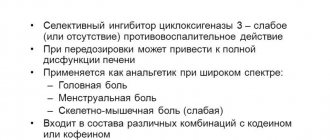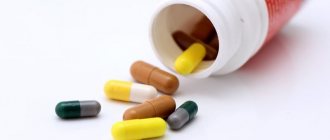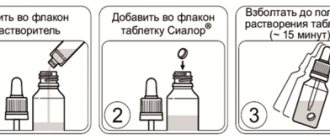We all need protection to one degree or another. External and internal. The body and mind are quite fragile and can be strengthened and supported in different ways. Even with medication.
If a person experiences negative effects (stress, shock, ischemia, intoxication, cerebrovascular accident, etc.), then the doctor may prescribe Mexidol.
Mexidol is a good helper in the fight against stress
Composition and release form
Active ingredient: ethylmethylhydroxypyridine succinate – 50 mg. Excipients: sodium metabisulfite – 0.4 mg; water for injections up to 1 ml. Solution for intravenous and intramuscular administration 50 mg/ml in colorless or light-protective glass ampoules with a blue break point or a white break point and three marking rings (top - yellow, middle - white, bottom - red) 2 ml or 5 ml . 5 ampoules in a blister pack. 1 or 2 blister packs along with instructions for medical use in a cardboard pack. 4, 10 or 20 blister packs along with instructions for medical use in a box of cardboard (for hospitals).
Features of application at low pressure
The decrease in blood pressure when taking Mexidol is due to increased synthesis and accumulation of natriuretic peptide, which promotes the removal of sodium salts and water from the body (diuretic effect).
The moderate hypotensive effect of the drug requires careful use in patients with low levels of:
- at values of 110/70-90/60 – it is allowed to take a standard dose of Mexidol;
- less than 90/60 – consultation with a specialist is required about the advisability of prescribing the drug and the need for pressure correction.
For mild hypotension, Mexidol is recommended due to its ability to normalize the autonomic innervation of the vascular wall and increase indicators to optimal values.
Drug interactions: the drug enhances the effect of antihypertensive drugs (beta-blockers, diuretics), therefore it is prescribed with caution to patients with mild hypertension.
pharmachologic effect
Antioxidant agent. Means for the correction of disorders in alcoholism, toxic and drug addiction.
Pharmacokinetics
With intramuscular administration, it is determined in the blood plasma for 4 hours after administration. The time to reach the maximum concentration Tmax is 0.45-0.5 hours. Cmax when administering a dose of 400-500 mg is 3.5-4.0 μg/ml. Mexidol quickly passes from the bloodstream into organs and tissues and is quickly eliminated from the body. The drug retention time (MRT) is 0.7-1.3 hours. The drug is excreted mainly in the urine, mainly in glucurone-conjugated form and in small quantities unchanged.
Pharmacodynamics
It has antihypoxic, membrane-protective, nootropic, anticonvulsant, anxiolytic effects, and increases the body's resistance to stress.
The drug increases the body's resistance to the effects of major damaging factors, to oxygen-dependent pathological conditions (shock, hypoxia and ischemia, cerebrovascular accident, intoxication with alcohol and antipsychotic drugs (neuroleptics)). Mexidol improves cerebral metabolism and blood supply to the brain, improves microcirculation and rheological properties of blood, and reduces platelet aggregation. Stabilizes the membrane structures of blood cells (erythrocytes and platelets) during hemolysis. It has a hypolipidemic effect, reduces the level of total cholesterol and LDL. Reduces enzymatic toxemia and endogenous intoxication in acute pancreatitis. The mechanism of action of Mexidol is due to its antihypoxic, antioxidant and membrane protective effects. It inhibits the processes of lipid peroxidation, increases the activity of superoxide dismutase, increases the lipid-protein ratio, reduces membrane viscosity, and increases its fluidity. Modulates the activity of membrane-bound enzymes (calcium-independent phosphodiesterase, adenylate cyclase, acetylcholinesterase), receptor complexes (benzodiazepine, GABA, acetylcholine), which enhances their ability to bind to ligands, helps preserve the structural and functional organization of biomembranes, transport of neurotransmitters and improve synaptic transmission.
Mexidol increases dopamine levels in the brain. Causes an increase in the compensatory activity of aerobic glycolysis and a decrease in the degree of inhibition of oxidative processes in the Krebs cycle under hypoxic conditions, with an increase in the content of ATP, creatine phosphate and activation of the energy-synthesizing functions of mitochondria, stabilization of cell membranes. Mexidol normalizes metabolic processes in the ischemic myocardium, reduces the necrosis zone, restores and improves the electrical activity and contractility of the myocardium, and also increases coronary blood flow in the ischemic zone, reduces the consequences of reperfusion syndrome in acute coronary insufficiency. Increases the antianginal activity of nitro drugs. Mexidol promotes the preservation of retinal ganglion cells and optic nerve fibers during progressive neuropathy, the causes of which are chronic ischemia and hypoxia. Improves the functional activity of the retina and optic nerve, increasing visual acuity.
Mexidol 50mg/ml 5ml 5 pcs. solution for intravenous and intramuscular administration
pharmachologic effect
Antioxidant agent.
Means for the correction of disorders in alcoholism, toxic and drug addiction.
Composition and release form Mexidol 50 mg/ml 5 ml 5 pcs. solution for intravenous and intramuscular administration
- Active ingredient: ethylmethylhydroxypyridine succinate – 50 mg.
- Excipients: sodium metabisulfite – 0.4 mg; water for injections up to 1 ml.
Solution for intravenous and intramuscular administration 50 mg/ml in colorless or light-protective glass ampoules with a blue break point or a white break point and three marking rings (top - yellow, middle - white, bottom - red) 2 ml or 5 ml . 5 ampoules in a blister pack. 1 or 2 blister packs along with instructions for medical use in a cardboard pack. 4, 10 or 20 blister packs along with instructions for medical use in a box of cardboard (for hospitals).
Description of the dosage form
Colorless or slightly yellowish transparent liquid in ampoules of 2 or 5 ml.
Directions for use and doses
IM or IV (stream or drip). When administered by infusion, the drug should be diluted in 0.9% sodium chloride solution.
Mexidol® is administered slowly over 5–7 minutes in a stream, and dropwise at a rate of 40–60 drops per minute. The maximum daily dose should not exceed 1200 mg.
For acute cerebrovascular accidents, Mexidol® is used in the first 10–14 days - 200–500 mg IV drip 2–4 times a day, then 200–250 mg IM 2–3 times a day for 2 weeks .
For traumatic brain injury and the consequences of traumatic brain injuries, Mexidol® is used for 10-15 days intravenously at a dose of 200–500 mg 2–4 times a day.
For dyscirculatory encephalopathy in the decompensation phase, Mexidol® should be prescribed intravenously in a stream or drip at a dose of 200–500 mg 1–2 times a day for 14 days. Then IM 100–250 mg/day over the next 2 weeks.
For a course of prophylaxis of discirculatory encephalopathy, the drug is administered intramuscularly at a dose of 200–250 mg 2 times a day for 10–14 days.
For mild cognitive impairment in elderly patients and anxiety disorders, the drug is used intramuscularly at a daily dose of 100–300 mg/day for 14–30 days.
In case of acute myocardial infarction, as part of complex therapy, Mexidol® is administered intravenously or intramuscularly for 14 days, against the background of traditional therapy for myocardial infarction, including nitrates, beta-blockers, angiotensin-converting enzyme (ACE) inhibitors, thrombolytics, anticoagulant and antiplatelet agents, as well as symptomatic means according to indications.
In the first 5 days, to achieve maximum effect, it is advisable to administer the drug intravenously; in the next 9 days, Mexidol® can be administered intramuscularly.
Intravenous administration of the drug is carried out by drip infusion, slowly (to avoid side effects) in a 0.9% sodium chloride solution or 5% dextrose (glucose) solution in a volume of 100–150 ml for 30–90 minutes. If necessary, a slow jet injection of the drug, lasting at least 5 minutes, is possible.
The drug is administered (intravenous or intramuscular) 3 times a day, every 8 hours. The daily therapeutic dose is 6-9 mg/kg body weight per day, a single dose is 2-3 mg/kg body weight. The maximum daily dose should not exceed 800 mg, single dose - 250 mg.
For open-angle glaucoma of various stages, as part of complex therapy, Mexidol® is administered intramuscularly at 100–300 mg/day, 1–3 times a day for 14 days.
For alcohol withdrawal syndrome, Mexidol® is administered in a dose of 200–500 mg intravenously or intramuscularly 2–3 times a day for 5–7 days.
In case of acute intoxication with antipsychotic drugs, the drug is administered intravenously at a dose of 200-500 mg/day for 7-14 days. In acute purulent-inflammatory processes of the abdominal cavity (acute necrotizing pancreatitis, peritonitis), the drug is prescribed on the first day both in the preoperative and postoperative periods. The administered doses depend on the form and severity of the disease, the prevalence of the process, and variants of the clinical course. The drug should be discontinued gradually only after a stable positive clinical and laboratory effect.
For acute edematous (interstitial) pancreatitis, Mexidol® is prescribed 200–500 mg 3 times a day, intravenously (in 0.9% sodium chloride solution) and intramuscularly. Mild severity of necrotizing pancreatitis - 100-200 mg 3 times a day intravenously (in 0.9% sodium chloride solution) and intramuscularly. Moderate severity - 200 mg 3 times a day intravenously (in 0.9% sodium chloride solution). Severe course - in a pulse dosage of 800 mg on the first day with a double dose regimen; then 200–500 mg 2 times a day with a gradual reduction in the daily dose. Extremely severe course - at an initial dosage of 800 mg/day until the manifestations of pancreatogenic shock are persistently relieved, after stabilization of the condition, 300-500 mg 2 times a day intravenously (in 0.9% sodium chloride solution) with a gradual decrease in the daily dosage.
Pharmacodynamics
It has antihypoxic, membrane-protective, nootropic, anticonvulsant, anxiolytic effects, and increases the body's resistance to stress. The drug increases the body's resistance to the effects of major damaging factors, to oxygen-dependent pathological conditions (shock, hypoxia and ischemia, cerebrovascular accident, intoxication with alcohol and antipsychotic drugs (neuroleptics)).
Mexidol improves cerebral metabolism and blood supply to the brain, improves microcirculation and rheological properties of blood, and reduces platelet aggregation.
Stabilizes the membrane structures of blood cells (erythrocytes and platelets) during hemolysis.
It has a hypolipidemic effect, reduces the level of total cholesterol and LDL.
Reduces enzymatic toxemia and endogenous intoxication in acute pancreatitis.
The mechanism of action of Mexidol is due to its antihypoxic, antioxidant and membrane protective effects. It inhibits the processes of lipid peroxidation, increases the activity of superoxide dismutase, increases the lipid-protein ratio, reduces membrane viscosity, and increases its fluidity. Modulates the activity of membrane-bound enzymes (calcium-independent phosphodiesterase, adenylate cyclase, acetylcholinesterase), receptor complexes (benzodiazepine, GABA, acetylcholine), which enhances their ability to bind to ligands, helps preserve the structural and functional organization of biomembranes, transport of neurotransmitters and improve synaptic transmission.
Mexidol increases dopamine levels in the brain. Causes an increase in the compensatory activity of aerobic glycolysis and a decrease in the degree of inhibition of oxidative processes in the Krebs cycle under hypoxic conditions, with an increase in the content of ATP, creatine phosphate and activation of the energy-synthesizing functions of mitochondria, stabilization of cell membranes. Mexidol normalizes metabolic processes in the ischemic myocardium, reduces the necrosis zone, restores and improves the electrical activity and contractility of the myocardium, and also increases coronary blood flow in the ischemic zone, reduces the consequences of reperfusion syndrome in acute coronary insufficiency. Increases the antianginal activity of nitro drugs. Mexidol promotes the preservation of retinal ganglion cells and optic nerve fibers during progressive neuropathy, the causes of which are chronic ischemia and hypoxia. Improves the functional activity of the retina and optic nerve, increasing visual acuity.
Pharmacokinetics
With intramuscular administration, it is determined in the blood plasma for 4 hours after administration. The time to reach the maximum concentration Tmax is 0.45-0.5 hours. Cmax when administering a dose of 400-500 mg is 3.5-4.0 μg/ml. Mexidol quickly passes from the bloodstream into organs and tissues and is quickly eliminated from the body. The drug retention time (MRT) is 0.7-1.3 hours. The drug is excreted mainly in the urine, mainly in glucurone-conjugated form and in small quantities unchanged.
Indications for use Mexidol 50 mg/ml 5 ml 5 pcs. solution for intravenous and intramuscular administration
- acute cerebrovascular accidents;
- traumatic brain injury, consequences of traumatic brain injury;
- iscirculatory encephalopathy;
- autonomic dystonia syndrome;
- mild cognitive disorders of atherosclerotic origin;
- anxiety disorders in neurotic and neurosis-like conditions;
- acute myocardial infarction (from the first day) as part of complex therapy;
- primary open-angle glaucoma of various stages, as part of complex therapy;
- relief of withdrawal syndrome in alcoholism with a predominance of neurosis-like and vegetative-vascular disorders;
- acute intoxication with antipsychotic drugs;
- acute purulent-inflammatory processes of the abdominal cavity (acute necrotizing pancreatitis, peritonitis) as part of complex therapy.
Contraindications
- Acute dysfunction of the liver and kidneys, increased individual sensitivity to the drug. Strictly controlled clinical studies of the safety of the drug
- Mexidol has not been used in children, pregnancy or breastfeeding.
special instructions
In some cases, especially in predisposed patients with bronchial asthma with increased sensitivity to sulfites, severe hypersensitivity reactions may develop.
Overdose
In case of overdose, drowsiness may develop.
Side effects Mexidol 50 mg/ml 5 ml 5 pcs. solution for intravenous and intramuscular administration
Nausea and dry mouth, drowsiness, and allergic reactions may occur.
Drug interactions
Enhances the effect of benzodiazepine anxiolytics, anticonvulsants (carbamazepine), antiparkinsonian drugs (levodopa). Reduces the toxic effects of ethyl alcohol.
Indications for use of Mexidol
- acute cerebrovascular accidents;
- traumatic brain injury, consequences of traumatic brain injury;
- iscirculatory encephalopathy;
- autonomic dystonia syndrome;
- mild cognitive disorders of atherosclerotic origin;
- anxiety disorders in neurotic and neurosis-like conditions;
- acute myocardial infarction (from the first day) as part of complex therapy;
- primary open-angle glaucoma of various stages, as part of complex therapy;
- relief of withdrawal syndrome in alcoholism with a predominance of neurosis-like and vegetative-vascular disorders;
- acute intoxication with antipsychotic drugs;
- acute purulent-inflammatory processes of the abdominal cavity (acute necrotizing pancreatitis, peritonitis) as part of complex therapy.
The use of Mexidol for parkinsonism
Parkinsonism (Parkinson's disease) is a neurological pathology that is characterized by a progressive decrease in the amplitude and accuracy of movements, against the background of which tremor (shaking) of the limbs develops. Most often, the disease is diagnosed in older people (over 55 years old).
The morphological basis of the disease is associated with a violation of the synthesis of dopamine, a mediator of nerve impulses, in the substantia nigra of the brain. Standard treatment for pathology involves the use of replacement therapy with active precursors of the substance.
Long-term use of such drugs contributes to metabolic disorders in neurons, which is manifested by the synthesis of free radicals and damage to the cell membrane. An integrated approach using antihypoxic agents additionally affects peripheral structures and improves metabolism in the brain.
Clinical studies using Mexidol in the treatment of Parkinson's disease noted:
- increasing the speed of impulse transmission along the nerve (during a study on an electroneuromyograph);
- reducing the manifestations of tremor (oscillations) and increasing the amplitude of movements;
- increased efficiency and the possibility of reducing the dose of basic antiparkinsonian drugs (illustrated using the example of Cyclodol);
- reduction in the severity of symptoms (unsteadiness of gait, tremors in the hands, stiffness of movements) according to the Hen-Yahru scale;
- an increase in the concentration of dopamine metabolic products in the blood (results of an experimental study at the Center for Extrapyramidal Diseases).
As part of complex therapy, Mexidol is recommended for patients with Parkinson's disease at a dose of 200-400 mg/day in the form of a dropper (4-8 ml of a 5% solution of the drug per 250-300 ml of saline).
Mexidol dosage
IM or IV (stream or drip). When administered by infusion, the drug should be diluted in 0.9% sodium chloride solution.
Mexidol® is administered slowly over 5–7 minutes in a stream, and dropwise at a rate of 40–60 drops per minute. The maximum daily dose should not exceed 1200 mg.
For acute cerebrovascular accidents, Mexidol® is used in the first 10–14 days - 200–500 mg IV drip 2–4 times a day, then 200–250 mg IM 2–3 times a day for 2 weeks .
For traumatic brain injury and the consequences of traumatic brain injuries, Mexidol® is used for 10-15 days intravenously at a dose of 200–500 mg 2–4 times a day.
For dyscirculatory encephalopathy in the decompensation phase, Mexidol® should be prescribed intravenously in a stream or drip at a dose of 200–500 mg 1–2 times a day for 14 days. Then IM 100–250 mg/day over the next 2 weeks.
For a course of prophylaxis of discirculatory encephalopathy, the drug is administered intramuscularly at a dose of 200–250 mg 2 times a day for 10–14 days.
For mild cognitive impairment in elderly patients and anxiety disorders, the drug is used intramuscularly at a daily dose of 100–300 mg/day for 14–30 days.
In case of acute myocardial infarction, as part of complex therapy, Mexidol® is administered intravenously or intramuscularly for 14 days, against the background of traditional therapy for myocardial infarction, including nitrates, beta-blockers, angiotensin-converting enzyme (ACE) inhibitors, thrombolytics, anticoagulant and antiplatelet agents, as well as symptomatic means according to indications.
In the first 5 days, to achieve maximum effect, it is advisable to administer the drug intravenously; in the next 9 days, Mexidol® can be administered intramuscularly.
Intravenous administration of the drug is carried out by drip infusion, slowly (to avoid side effects) in a 0.9% sodium chloride solution or 5% dextrose (glucose) solution in a volume of 100–150 ml for 30–90 minutes. If necessary, a slow jet injection of the drug, lasting at least 5 minutes, is possible.
The drug is administered (intravenous or intramuscular) 3 times a day, every 8 hours. The daily therapeutic dose is 6-9 mg/kg body weight per day, a single dose is 2-3 mg/kg body weight. The maximum daily dose should not exceed 800 mg, single dose - 250 mg.
For open-angle glaucoma of various stages, as part of complex therapy, Mexidol® is administered intramuscularly at 100–300 mg/day, 1–3 times a day for 14 days.
For alcohol withdrawal syndrome, Mexidol® is administered in a dose of 200–500 mg intravenously or intramuscularly 2–3 times a day for 5–7 days.
In case of acute intoxication with antipsychotic drugs, the drug is administered intravenously at a dose of 200-500 mg/day for 7-14 days. In acute purulent-inflammatory processes of the abdominal cavity (acute necrotizing pancreatitis, peritonitis), the drug is prescribed on the first day both in the preoperative and postoperative periods. The administered doses depend on the form and severity of the disease, the prevalence of the process, and variants of the clinical course. The drug should be discontinued gradually only after a stable positive clinical and laboratory effect.
For acute edematous (interstitial) pancreatitis, Mexidol® is prescribed 200–500 mg 3 times a day, intravenously (in 0.9% sodium chloride solution) and intramuscularly. Mild severity of necrotizing pancreatitis - 100-200 mg 3 times a day intravenously (in 0.9% sodium chloride solution) and intramuscularly. Moderate severity - 200 mg 3 times a day intravenously (in 0.9% sodium chloride solution). Severe course - in a pulse dosage of 800 mg on the first day with a double dose regimen; then 200–500 mg 2 times a day with a gradual reduction in the daily dose. Extremely severe course - at an initial dosage of 800 mg/day until the manifestations of pancreatogenic shock are persistently relieved, after stabilization of the condition, 300-500 mg 2 times a day intravenously (in 0.9% sodium chloride solution) with a gradual decrease in the daily dosage.
Side effects
One of the side effects after taking Mexidol may be nausea
Despite the body’s positive reaction to taking Mexidol and its low toxicity, the medicine still has side effects.
- from the cardiovascular system: increased blood pressure, decreased blood pressure;
- from the nervous system: drowsiness, difficulty falling asleep, anxiety, emotional reactivity, headache, loss of coordination;
- from the gastrointestinal tract: nausea, dry mouth;
- from the immune system: allergic reactions, including hyperemia, skin rash, itching;
- others: distal hyperhidrosis.
Analogues and domestic substitutes
The domestic manufacturer offers patients many analogues - products that differ in name and cost: Mexiprim, Neurox, Astrox, Meksifin, Neurocard, Proinin.
Complex therapy in an inpatient clinic for neurological and cardiovascular diseases is accompanied by the use of antioxidants and other agents that improve metabolism.
The drugs most used in clinical practice are:
- nootropics (to improve cognitive abilities, accelerate metabolic processes in the brain): Piracetam, Pantogam, Bifren, Noofen, Cerebrolysin;
- “Actovegin” is a product made from dried calf blood extract, which increases tissue resistance to hypoxia, improves metabolic processes, and accelerates the healing of ulcers and wounds;
- "Mydocalm" is a drug used in neurology for the treatment of diseases with increased muscle tone (multiple sclerosis, parkinsonism), postoperative and traumatic contractures;
- "Meldonium" ("Mildronate") is a universal metabolic agent that is used in cardiology to restore the myocardium after a heart attack;
- vitamin preparations with antioxidant and neuroprotective effects: “Milgamma” (group B complex), “Aevit” (A+E).
Autonomic disorders caused by compression of nerve roots due to osteochondrosis require complex therapy:
- diuretics (“Furosemide”);
- nonsteroidal anti-inflammatory drugs (“Voltaren”, “Diclofenac”);
- muscle relaxants - to relax spastic back muscles (Mydocalm, Baclofen).
To relieve headaches, doctors recommend drugs with proven effectiveness - Spazmalgon, Ibuprofen.
How often can the course of treatment be repeated?
Mexidol is a drug that is used to systemically improve cellular metabolic processes. Experts recommend taking the product regularly, in short or medium-duration courses:
- 10-14 days - every 2 months;
- 6 weeks - once every 6-12 months.
It is always prohibited to use Mexidol due to addiction and reduced effectiveness of the drug. For long-term correction of oxidative processes in the body, the use of other means is recommended during the pause.
conclusions
Mexidol is a drug from the group of antioxidant nootropic drugs, which is widely used in medical practice for the complex treatment of acute and chronic disorders. A competent approach to prescribing and checking for compatibility with other medications is the key to the effectiveness of treatment. There is no evidence base for monotherapy with Mexidol, so independent use of the drug for diagnosed neurological diseases is accompanied by the risk of progression of the pathology and a worsening prognosis for the patient’s life.






